Security-Constrained Unit Commitment Considering Differentiated Regional Air Pollutant Intensity
Abstract
:1. Introduction
- Gaussian puff dispersion is used to model the transport of emissions, and the contribution of emissions to air pollutant concentration increments in targeted regions is calculated. The API is calculated as the ratio of local air pollutant concentration to local AEC-based threshold concentration. The API constraints are formulated and integrated into typical SCUC.
- The Monte Carlo simulation with Latin hypercube sampling (LHS) and scenario reduction is used to generate wind power volatility scenarios. Additionally, Benders decomposition is used to solve the formulated stochastic mixed-integer quadratic programming (MIQP) problem.
- Case studies prove the effectiveness of the proposed model in improving air quality for densely populated region and reducing the person-hours exposed to severe air pollution for the entire region via shifting generation among units.
- Compared to undifferentiated dispatches, the Eco-SCUC considers trans-regional pollutant dispersion effects and differentiated population exposure to harmful pollutants. Instead of enforcing uniform regulations on emission, API constraints are formulated according to the differentiated impacts of coal-fired units on regional air quality. The model succeeds in mitigating the air pollution in densely-populated regions via shifting generation away from high-impact units to low-impact units and wind power.
2. Formulating Differentiated API Constraints
2.1. Gaussian Puff Dispersion
2.2. Atmoshperic Environmental Capacity (AEC)
2.3. Air Pollutant Intensity (API)
2.4. Differentiated API Constraints
3. Formulating Wind Power Scenarios
3.1. Distribution of Wind Speed
3.2. Distribution of Wind Power
3.3. Scenario Generation and Reduction
4. Modeling Eco-SCUC
4.1. Integrating Wind Power Scenarios
4.1.1. Objective Function
4.1.2. Hourly Constraints
4.1.3. Scenario Constraints
4.2. Integrating API Constraints
4.3. Solution Methodology
5. Case Studies
5.1. Description
5.2. Results
- Even with integration of wind power, the API constraints are still necessary in the dispatch model to mitigate air quality deterioration. For example, in Table 1 in R1, Cav in Case 2 is only 0.4% lower than Case 1, while Cav in Case 4 is 16.6% lower than Case 1. Although Case 2 decreases its fuel consumption because of less power demand from coal-fired units, it fails to effectively mitigate regional air quality degradation.
- The dispatch minimizing total emissions may encourage emission reductions at wrong locations and times regarding regional air quality control. In Table 1 in R1, Cav and Cpk in Case 4 are 9.5% and 12.7% lower than Case 3, respectively. This justifies that both weather conditions and geographical distribution of system are critical in environmental dispatch.
- The proposed Eco-SCUC takes advantage of wind generation and API constraints, and it can cost-effectively alleviate air quality deterioration for densely populated regions. Via shifting generation among units, the Eco-SCUC succeeds in balancing regional air quality saturation level. Although the Eco-SCUC improves regional air quality at a cost of slight increase of total costs and emissions, it can significantly reduce the person-hour exposure to severe air pollution, which is beneficial to human and environmental health.
5.3. Discussion
- Environmental or ecological taxes can be imposed to power plants based on the violation of API constraints. In the Eco-SCUC, the violation of API constraint can be directly linked to the ecosystem or human health damages. This solves the problem that the impact of coal-fired power plants on regional air quality cannot be quantitatively analyzed.
- Air quality compensation mechanism can be implemented by the government to press the power plants to adjust their generation in response to regional air quality. The Eco-SCUC helps calculate the compensated amount based on regional API changes.
- The developing cyber-physical system (CPS) technologies enable power grid corporations to expand their ancillary services to include API-associated regulations, thereby improving regional air quality.
6. Conclusions
Author Contributions
Acknowledgments
Conflicts of Interest
Nomenclature
| A. Acronyms | |
| ED | Economic dispatch |
| UC | Unit commitment |
| SCUC | Security-constrained unit commitment |
| Eco-SCUC | Ecology- and security-constrained unit commitment |
| AEC | Atmospheric environmental capacity |
| API | Air pollutant intensity |
| LHS | Latin hypercube sampling |
| CDF | Cumulative distribution function |
| Probability density function | |
| MIQP | Mixed-integer quadratic programming |
| B. Sets and indices | |
| t | Index for time |
| τ | Index for pollutant emitting time |
| i | Index for unit |
| j | Index for monitoring point |
| s | Index for wind power generation scenario |
| C. Parameters | |
| (xp,yp,zp) | Coordinates of dispersion puff center |
| (xs,ys,zs) | Coordinates of the emitting stack |
| (xj, yj, zj) | Coordinates of concentration monitoring location |
| Ψ, λ, h | Intermediary parameter |
| σx/y/z(·) | Standard deviation in x/y/z direction of the puff center |
| Δn | Equal time interval of dispersion period (t-τ), n = 1, 2, …N |
| vx/y/z(n) | Wind velocity in x/y/z direction during time interval Δn |
| ϖ | Atmospheric stability class A–F |
| a(·)/b(·)/α(·)/β(·) | Atmospheric stability coefficients |
| si | Pollutant emission per unit fuel of unit i, ton/ton |
| γi | Fuel cost of unit i, $/ton |
| Fi | Fuel consumption function of unit i, ton |
| ai, bi, ci | Fuel consumption coefficients of unit i, ton/MW2h, ton/mwh, ton/h |
| Volume-average value of concentration c, μg/m3 | |
| Initial volume-average concentration, μg/m3 | |
| ρ | Atmospheric volume, m3 |
| / | Advection/pseudo-diffusion speed, m/s |
| ηρ | Removal rate of air pollutant in the examined volume ρ, ton/a |
| ηtj | Removal rate of air pollutant at location j and time t, ton/a |
| δρ | Dirac function for the examined volume ρ |
| / | Dry/wet deposition speed, m/s |
| A | AEC coefficient, m2/s |
| U | Predicted wind speed, m/s |
| H | Height of atmospheric boundary layer, m |
| S | Area of the examined region, km2 |
| v | Value of random wind speed variable V, m/s |
| vm | Mth sampled wind speed value, m/s |
| /s | Average/sample variance of measured wind speed, m/s |
| FV(v)/fV(v) | CDF/PDF of random V |
| c/k | Scale/shape factor at the predefined region |
| μ/ | Mean/standard variance of wind speed |
| Γ(·) | Gamma function |
| pw | Value of random wind power variable PW, MW |
| pwr | Rated wind power, MW |
| vr, vin, vout | Rated/cut-in/cut-out wind speed, m/s |
| NT | Number of periods under study (24-h) |
| NG | Number of coal units |
| NW | Number of wind-powered units |
| NM | Sample number of measured wind speed |
| NJ | Number of air quality monitoring points |
| ΔT | Time interval of dispatch (1 h) |
| Forecasted generation of wind-powered unit i at time t, MW | |
| Uit/Dit | Startup/shutdown cost of unit i at time t, $ |
| PDt/PLt | System demand/losses at time t, MW |
| RSt/ROt | System spinning/operating reserve requirement at time t, MW |
| Minimum on/off time of unit i | |
| Pi,min/Pi,max | Lower/upper limit of real power generation of unit i, MW |
| / | Ramping up/down limit of unit i, MW |
| RUt/RDt | System regulation up/down limit at time t, MW |
| SF | Shift factor matrix |
| KP/W/D | Bus-unit/bus-wind/bus-load incidence matrix |
| PD/PL | System demand/losses vector |
| Mtj | Penalty function for location j at time t |
| ζtj | Artificial slack variable for location j at time t |
| D. Variables | |
| Gi(·) | Gaussian puff dispersion function |
| Ci(t;j) | Change of pollutant concentration caused by unit i at time t at location j, μg/m3 |
| CT,tj | Threshold concentration at location j and time t, μg/m3 |
| C0,tj | Background concentration at location j and time t, μg/m3 |
| Cav/Cpk | Daily average/peak concentration of pollutant, μg/m3 |
| Qi(t) | Pollutant emission of unit i at time t, ton |
| pit | Generation of coal-fired unit i at time t, MW |
| pwit | Generation of wind-powered unit i at time t, MW |
| API(t;j) | API at location j and time t, % |
| APIi(t;j) | Change of API caused by unit i at location j and time t, % |
| API0,tj | Background API at location j and time t, % |
| APIE,tj | Expected API at location j and time t, % |
| Iit | Binary commitment of unit i at time t |
| On/off time of unit i at time t | |
| RUit/RDit | Regulation up/down capacity of unit i at time t, MW |
| RSit/ROit | Spinning/operating reserve of unit i at time t, MW |
| P | Vector of generation of coal-fired units |
| PW | Vector of generation of wind-powered units |
Appendix A
Appendix A.1
Appendix A.2
Appendix A.3
Appendix A.4
Appendix B
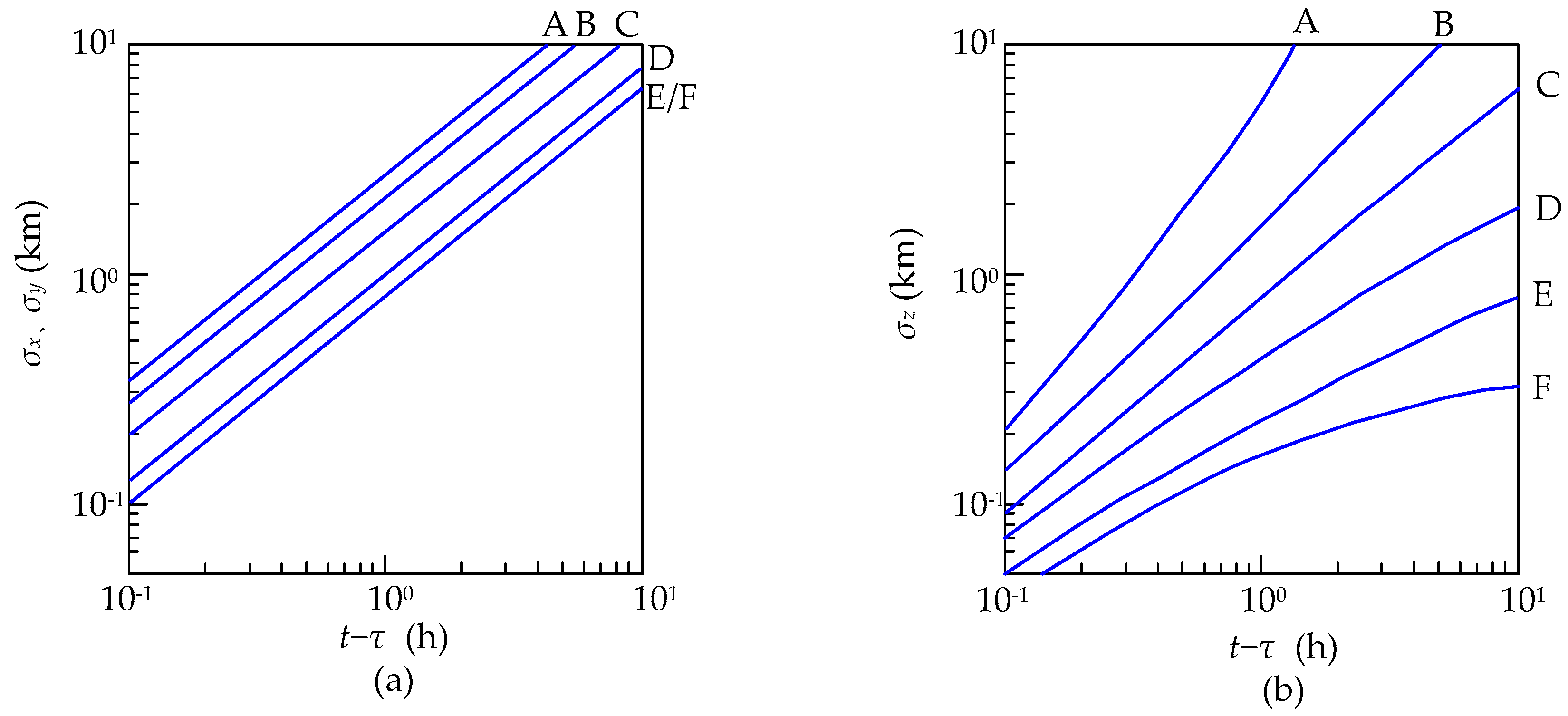
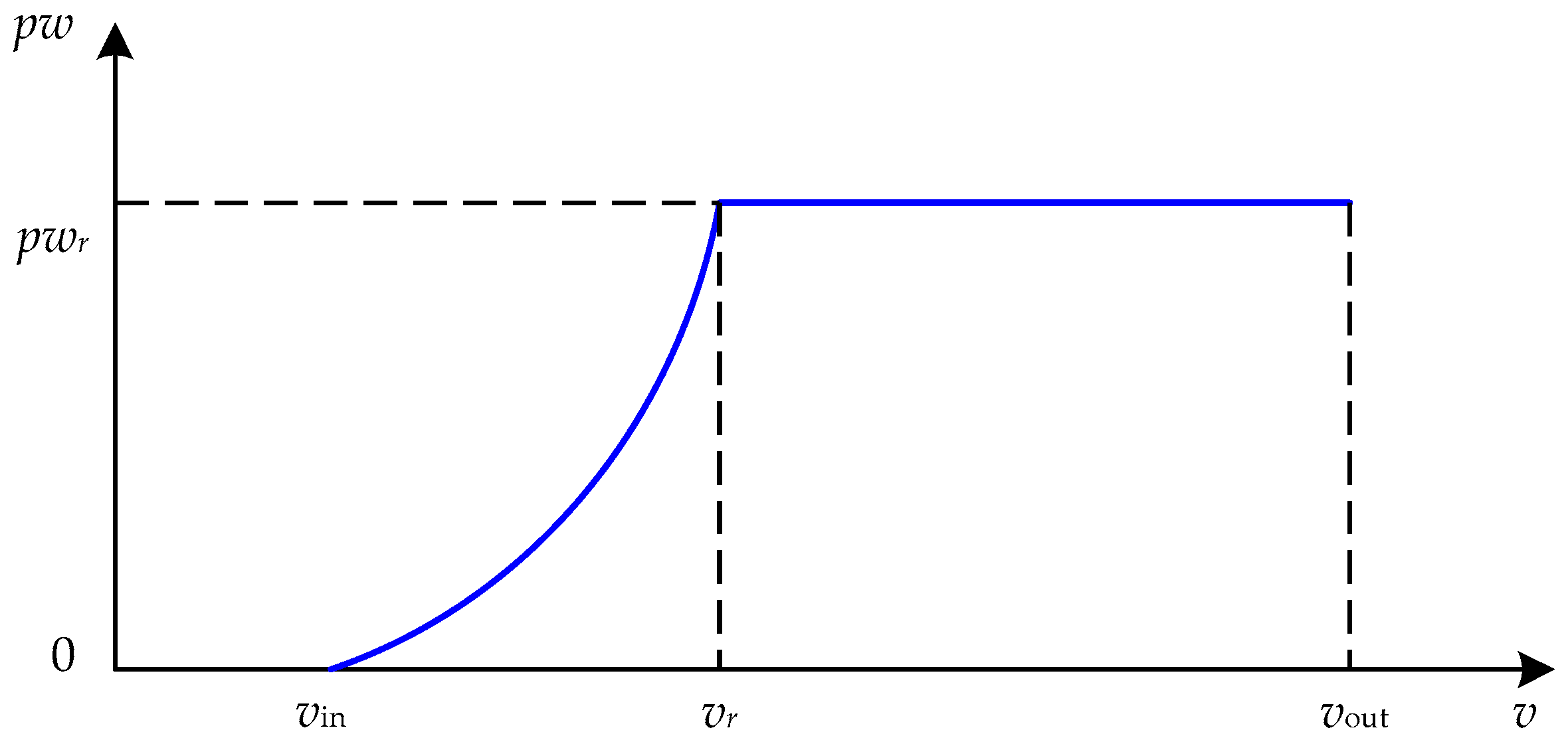
| Total/Low Cloud Coverage (1/10) | Solar Altitude (°) | ||||
|---|---|---|---|---|---|
| Night | ≤15 | 15–35 | 35–65 | >65 | |
| ≤4/≤4 | −2 | −1 | +1 | +2 | +3 |
| 5–7/≤4 | −1 | 0 | +1 | +2 | +3 |
| ≥8/≤4 | −1 | 0 | 0 | +1 | +1 |
| ≥5/5–7 | 0 | 0 | 0 | 0 | +1 |
| ≥8/≥8 | 0 | 0 | 0 | 0 | +1 |
| Ground-Level Wind Speed(m/s) | Solar Radiation Level | |||||
|---|---|---|---|---|---|---|
| +3 | +2 | +1 | 0 | −1 | −2 | |
| ≤1.9 | A | A–B | B | D | E | F |
| 2–2.9 | A–B | B | C | D | E | F |
| 3–4.9 | B | B–C | C | D | D | E |
| 5–5.9 | C | C–D | D | D | D | D |
| ≥6 | C | D | D | D | D | D |
| Unit | Fuel Consumption Coefficients | Stack Parameters | |||||
|---|---|---|---|---|---|---|---|
| ai (ton/MW2h) | bi (ton/MWh) | ci (ton/h) | si (ton/ton) | xs (km) | ys (km) | zs (m) | |
| G1 | 0.001076 | 0.050572 | 21.2 | 0.00487 | 3 | 14 | 150 |
| G2 | 0.000960 | 0.050052 | 24.8 | 0.00465 | 23 | 9 | 150 |
| G3 | 0.001052 | 0.056072 | 16.0 | 0.00455 | 7 | 2 | 135 |
| G4 | 0.001132 | 0.063940 | 16.8 | 0.00495 | 22 | 24 | 105 |
| G5 | 0.001176 | 0.068860 | 13.2 | 0.00425 | 15 | 5 | 135 |
| G6 | 0.001528 | 0.069864 | 12.4 | 0.00413 | 8 | 18 | 135 |
| Unit | Generation Costs | On/Off Limits | Generation Limits | Ramp Limits | ||||
|---|---|---|---|---|---|---|---|---|
| γi ($/ton) | Uit ($) | Dit ($) | Ton (h) | Toff (h) | Pi,min (MW) | Pi,max (MW) | / (MW) | |
| G1 | 55.572 | 623.6 | 374.1 | 5 | 5 | 360 | 80 | 120/120 |
| G2 | 55.884 | 501.2 | 213.0 | 5 | 5 | 380 | 100 | 125/125 |
| G3 | 60.360 | 497.6 | 186.6 | 4 | 4 | 290 | 75 | 80/80 |
| G4 | 60.624 | 428.7 | 264.3 | 4 | 4 | 280 | 110 | 115/115 |
| G5 | 60.836 | 423.5 | 236.7 | 3 | 3 | 295 | 120 | 120/120 |
| G6 | 63.712 | 202.5 | 113.6 | 2 | 2 | 120 | 25 | 60/60 |
| Line | Initial Bus | Terminal Bus | Impedance (p.u.) | Power Flow Limit (MW) |
|---|---|---|---|---|
| 1 | 1 | 2 | 0.170 | 250 |
| 2 | 1 | 5 | 0.258 | 180 |
| 3 | 2 | 3 | 0.150 | 175 |
| 4 | 2 | 4 | 0.197 | 185 |
| 5 | 2 | 5 | 0.140 | 225 |
| 6 | 3 | 4 | 0.018 | 320 |
| 7 | 4 | 5 | 0.037 | 175 |
| 8 | 4 | 7 | 0.037 | 195 |
| 9 | 4 | 9 | 0.150 | 200 |
| 10 | 5 | 6 | 0.187 | 225 |
| 11 | 6 | 11 | 0.197 | 450 |
| 12 | 6 | 12 | 0.197 | 150 |
| 13 | 6 | 13 | 0.150 | 180 |
| 14 | 7 | 8 | 0.140 | 380 |
| 15 | 7 | 9 | 0.019 | 260 |
| 16 | 9 | 10 | 0.039 | 325 |
| 17 | 9 | 14 | 0.037 | 255 |
| 18 | 10 | 11 | 0.152 | 250 |
| 19 | 12 | 13 | 0.183 | 150 |
| 20 | 13 | 14 | 0.192 | 260 |
| t | (MW) | Bus-Load (MW) | |||||||
|---|---|---|---|---|---|---|---|---|---|
| Bus 4 | Bus 5 | Bus 7 | Bus 9 | Bus 10 | Bus 11 | Bus 12 | Bus 13 | ||
| 1 | 142. 6 | 190.2 | 113.1 | 83.7 | 98.4 | 93.8 | 177.1 | 107.1 | 55.2 |
| 2 | 131.0 | 204.2 | 121.4 | 89.9 | 105.6 | 100.8 | 190.1 | 115.0 | 59.1 |
| 3 | 123.8 | 203.6 | 121.1 | 89.6 | 105.3 | 100.5 | 189.5 | 114.7 | 58.8 |
| 4 | 142. 6 | 205.4 | 122.1 | 90.4 | 106.2 | 101.3 | 191.2 | 115.7 | 59.4 |
| 5 | 123.8 | 207.4 | 123.3 | 91.3 | 107.3 | 102.3 | 193.1 | 116.8 | 59.9 |
| 6 | 105.1 | 212.1 | 126.1 | 93.3 | 119.7 | 104.7 | 197.5 | 119.5 | 61.3 |
| 7 | 96.5 | 237.2 | 141.0 | 104.4 | 122.7 | 117.0 | 220.8 | 133.6 | 68.5 |
| 8 | 89.3 | 252.0 | 149.8 | 110.9 | 130.3 | 124.3 | 215.9 | 151.9 | 82.8 |
| 9 | 110.9 | 236.0 | 146.3 | 108.2 | 127.3 | 121.4 | 225.3 | 138.6 | 71.1 |
| 10 | 112.3 | 234.0 | 135.0 | 99.9 | 117.5 | 111.4 | 227.8 | 137.4 | 70.5 |
| 11 | 128.2 | 267.7 | 145.1 | 122.2 | 133.6 | 137.0 | 221.3 | 156.4 | 73.8 |
| 12 | 148.3 | 254.7 | 149.2 | 125.2 | 137.2 | 140.5 | 247.1 | 160.3 | 69.4 |
| 13 | 207.4 | 263.0 | 148.2 | 124.5 | 126.4 | 139.6 | 235.5 | 154.1 | 72.6 |
| 14 | 198.7 | 260.8 | 136.9 | 123.5 | 135.2 | 138.5 | 234.2 | 158.1 | 74.7 |
| 15 | 193.0 | 263.6 | 128.6 | 124.8 | 136.7 | 139.9 | 236.1 | 154.4 | 66.4 |
| 16 | 185.7 | 249.7 | 118.4 | 109.9 | 129.2 | 123.2 | 223.1 | 140.6 | 72.1 |
| 17 | 184.3 | 225.6 | 114.1 | 99.3 | 116.7 | 121.3 | 220.0 | 127.1 | 65.2 |
| 18 | 174.2 | 214.1 | 127.3 | 94.2 | 129.7 | 105.6 | 199.3 | 120.6 | 61.9 |
| 19 | 63.5 | 246.2 | 136.4 | 108.3 | 127.3 | 121.5 | 229.2 | 165.8 | 85.1 |
| 20 | 86.5 | 206.0 | 122.4 | 90.6 | 106.5 | 101.6 | 191.7 | 116.0 | 59.5 |
| 21 | 110.9 | 211.1 | 125.5 | 92.9 | 109.2 | 104.2 | 196.5 | 118.9 | 61.0 |
| 22 | 119.5 | 245.7 | 146.0 | 108.1 | 127.1 | 121.2 | 228.7 | 138.4 | 71.0 |
| 23 | 138.2 | 197.4 | 117.4 | 86.9 | 102.1 | 97.4 | 183.8 | 111.2 | 57.0 |
| 24 | 146.9 | 191.7 | 114.0 | 84.4 | 99.2 | 94.6 | 181.3 | 108.1 | 55.4 |
| t | Wind Power Volatility Scenario (MW) | |||||||||
|---|---|---|---|---|---|---|---|---|---|---|
| 1 | 2 | 3 | 4 | 5 | 6 | 7 | 8 | 9 | 10 | |
| 1 | 144.9 | 146.8 | 148.7 | 146.8 | 146.6 | 146.9 | 143.7 | 137.9 | 141.3 | 140.1 |
| 2 | 133.7 | 135.4 | 133.9 | 136.8 | 133.5 | 128.6 | 126.9 | 128.3 | 129.8 | 130.1 |
| 3 | 121.5 | 120.9 | 122.0 | 121.1 | 120.2 | 119.7 | 118.9 | 114.3 | 113.5 | 114.4 |
| 4 | 145.6 | 146.8 | 148.0 | 145.8 | 143.4 | 143.4 | 145.8 | 148.7 | 149.4 | 148.8 |
| 5 | 124.7 | 122.7 | 120.7 | 119.2 | 121.0 | 121.7 | 118.8 | 125.2 | 122.8 | 124.8 |
| 6 | 103.5 | 104.1 | 102.2 | 102.8 | 101.9 | 99.4 | 97.2 | 92.4 | 94.3 | 95.4 |
| 7 | 95.5 | 93.3 | 93.3 | 93.2 | 93.4 | 91.1 | 89.5 | 90.8 | 92.6 | 94.8 |
| 8 | 89.6 | 88.7 | 90.8 | 90.2 | 88.7 | 89.5 | 90.2 | 89.8 | 91.3 | 95.5 |
| 9 | 113.5 | 111.7 | 110.2 | 112.1 | 112.7 | 117.0 | 118.4 | 124.6 | 123.2 | 122.2 |
| 10 | 115.4 | 112.7 | 113.2 | 113.7 | 112.4 | 112.1 | 113.0 | 121.8 | 122.4 | 117.0 |
| 11 | 126.1 | 128.2 | 126.5 | 126.9 | 127.9 | 130.6 | 130.3 | 135.1 | 131.9 | 132.7 |
| 12 | 151.8 | 153.3 | 155.3 | 158.6 | 160.2 | 156.5 | 156.9 | 147.7 | 147.2 | 149.3 |
| 13 | 212.2 | 210.3 | 207.8 | 205.6 | 208.2 | 219.2 | 197.9 | 212.4 | 210.5 | 209.7 |
| 14 | 198.6 | 203.1 | 203.2 | 205.9 | 205.4 | 200.5 | 203.1 | 202.3 | 199.9 | 195.9 |
| 15 | 195.9 | 191.4 | 193.4 | 195.9 | 191.9 | 184.9 | 182.1 | 177.3 | 170.3 | 168.4 |
| 16 | 182.4 | 181.9 | 185.5 | 174.4 | 182.0 | 181.8 | 189.8 | 193.6 | 192.9 | 189.6 |
| 17 | 183.6 | 182.6 | 186.8 | 187.5 | 191.4 | 191.2 | 188.2 | 187.9 | 184.1 | 182.1 |
| 18 | 177.9 | 180.3 | 180.8 | 177.0 | 174.0 | 172.3 | 171.2 | 167.2 | 168.1 | 167.6 |
| 19 | 64.5 | 60.5 | 64.4 | 69.3 | 64.1 | 62.7 | 63.1 | 64.6 | 64.6 | 62.7 |
| 20 | 88.5 | 87.2 | 85.7 | 85.9 | 86.1 | 80.2 | 87.3 | 82.9 | 83.8 | 83.7 |
| 21 | 111.8 | 111.8 | 110.5 | 112.1 | 114.9 | 113.6 | 111.3 | 109.5 | 110.6 | 115.7 |
| 22 | 116.8 | 116.5 | 118.5 | 121.1 | 118.6 | 120.5 | 123.1 | 131.3 | 132.3 | 122.5 |
| 23 | 140.7 | 141.8 | 140.1 | 137.6 | 137.3 | 140.6 | 142.6 | 138.8 | 135.6 | 128.7 |
| 24 | 150.1 | 151.7 | 154.1 | 154.7 | 151.7 | 159.6 | 151.5 | 147.4 | 144.3 | 145.3 |
| t | G1 | G2 | G3 | G4 | G5 | G6 | ||||||||||||
|---|---|---|---|---|---|---|---|---|---|---|---|---|---|---|---|---|---|---|
| v1 | φ1 | ϖ1 | v | φ | ϖ | v | φ | ϖ | v | φ | ϖ | v | φ | ϖ | v | φ | ϖ | |
| 1 | 7.6 | 292 | D | 15.2 | 290 | E | 3.2 | 310 | E | 13.1 | 290 | D | 13.2 | 20 | E | 8.6 | 337 | F |
| 2 | 8.3 | 285 | D | 15.4 | 295 | E | 4.3 | 333 | E | 13.4 | 284 | D | 14.2 | 18 | E | 8.4 | 343 | F |
| 3 | 7.8 | 281 | D | 15.0 | 301 | E | 4.3 | 323 | E | 12.9 | 280 | D | 13.5 | 15 | E | 8.5 | 349 | F |
| 4 | 6.9 | 275 | D | 14.2 | 304 | E | 4.6 | 320 | E | 12.4 | 283 | D | 13.7 | 7 | E | 7.9 | 356 | F |
| 5 | 6.4 | 276 | D | 14.9 | 310 | E | 4.2 | 317 | E | 12.1 | 286 | D | 13.0 | 9 | E | 7.5 | 348 | F |
| 6 | 6.2 | 271 | D | 14.0 | 312 | E | 5.3 | 304 | E | 11.5 | 291 | D | 12.2 | 4 | E | 6.5 | 355 | F |
| 7 | 5.3 | 270 | F | 14.1 | 318 | F | 5.6 | 302 | D | 10.5 | 283 | F | 11.0 | 354 | F | 5.5 | 357 | D |
| 8 | 5.0 | 270 | F | 14.1 | 317 | F | 4.9 | 305 | D | 10.4 | 276 | F | 11.0 | 350 | F | 5.3 | 355 | D |
| 9 | 5.1 | 274 | F | 14.3 | 316 | F | 6.3 | 311 | D | 10.2 | 273 | F | 11.2 | 359 | F | 5 | 355 | D |
| 10 | 5.2 | 277 | F | 14.5 | 315 | F | 5.3 | 313 | D | 10.7 | 269 | F | 11.3 | 2 | F | 5.1 | 5 | D |
| 11 | 5.4 | 275 | F | 14.6 | 315 | F | 4.3 | 315 | D | 10.3 | 268 | F | 11.1 | 8 | F | 5.3 | 4 | D |
| 12 | 5.0 | 269 | F | 14.3 | 320 | F | 5.1 | 305 | D | 10.2 | 271 | F | 11.5 | 355 | F | 5.4 | 358 | D |
| 13 | 5.3 | 268 | F | 14.2 | 310 | E | 6.3 | 298 | F | 10.2 | 270 | C | 11.6 | 357 | E | 5.9 | 3 | F |
| 14 | 5.3 | 270 | F | 14.2 | 319 | E | 6.4 | 295 | F | 10.3 | 275 | C | 10.8 | 354 | E | 5.7 | 356 | F |
| 15 | 4.9 | 274 | F | 14.5 | 316 | E | 7.3 | 290 | F | 10.4 | 276 | C | 10.9 | 7 | E | 5.1 | 2 | F |
| 16 | 5.1 | 275 | F | 14.3 | 315 | E | 6.3 | 285 | F | 10.1 | 273 | C | 10.8 | 3 | E | 5.2 | 3 | F |
| 17 | 5.0 | 272 | F | 14.3 | 315 | E | 5.3 | 294 | F | 10.1 | 275 | C | 11.1 | 355 | E | 5 | 355 | F |
| 18 | 5.5 | 274 | F | 14.1 | 319 | D | 4.2 | 303 | E | 10.2 | 276 | C | 11.0 | 355 | D | 5.2 | 360 | D |
| 19 | 5.5 | 279 | F | 15.5 | 310 | D | 6.3 | 300 | E | 12.4 | 273 | C | 11.8 | 358 | D | 5.6 | 355 | D |
| 20 | 6.1 | 281 | F | 15.9 | 308 | D | 5.9 | 322 | E | 12.6 | 276 | C | 11.9 | 360 | D | 6.3 | 352 | D |
| 21 | 6.4 | 284 | F | 16.5 | 304 | D | 5.5 | 318 | E | 11.9 | 284 | C | 12.5 | 360 | D | 6.5 | 356 | D |
| 22 | 7.4 | 295 | F | 17.5 | 310 | D | 5.9 | 323 | E | 11.0 | 297 | C | 13.4 | 345 | D | 7.0 | 354 | D |
| 23 | 7.9 | 292 | D | 17.9 | 296 | D | 6.0 | 325 | E | 12.6 | 292 | C | 14.5 | 339 | D | 7.5 | 331 | D |
| 24 | 8.0 | 296 | D | 16.5 | 292 | D | 6.3 | 316 | E | 12.9 | 302 | C | 14.6 | 331 | D | 7.2 | 345 | D |
| t | Background Concentration C0,tj (μg/m3) | Threshold Concentration CT,tj (μg/m3) | Background API API0.tj (%) | ||||||||||||
|---|---|---|---|---|---|---|---|---|---|---|---|---|---|---|---|
| R1 1 | R2 | R3 | R4 | R5 | R1 | R2 | R3 | R4 | R5 | R1 | R2 | R3 | R4 | R5 | |
| 1 | 34.5 | 32.2 | 31.9 | 28.8 | 25.3 | 35.7 | 38.2 | 40.3 | 42.5 | 60.2 | 96.6 | 84.3 | 79.1 | 67.8 | 42.0 |
| 2 | 33.2 | 31.6 | 29.8 | 26.7 | 23.2 | 35.7 | 38.2 | 40.3 | 42.5 | 60.2 | 93.0 | 82.7 | 73.9 | 62.8 | 38.5 |
| 3 | 31.5 | 30.2 | 28.7 | 25.5 | 21.9 | 35.7 | 38.2 | 40.3 | 42.5 | 60.2 | 88.2 | 79.1 | 71.2 | 60.0 | 36.4 |
| 4 | 30.8 | 29.8 | 28.8 | 25.7 | 21.5 | 35.3 | 37.5 | 39.8 | 42.3 | 60.2 | 87.3 | 79.5 | 72.4 | 60.8 | 35.7 |
| 5 | 31.5 | 30.3 | 28.8 | 25.8 | 22.5 | 35.3 | 37.5 | 39.8 | 42.3 | 60.2 | 89.2 | 80.8 | 72.4 | 61.0 | 37.4 |
| 6 | 33.6 | 32.4 | 29.3 | 26.1 | 23.6 | 35.3 | 37.5 | 39.8 | 42.3 | 60.2 | 95.2 | 86.4 | 73.6 | 61.7 | 39.2 |
| 7 | 36.4 | 33.5 | 30.7 | 26.9 | 24.3 | 35.1 | 37.5 | 39.5 | 42.2 | 59.5 | 103.7 | 89.3 | 77.7 | 63.7 | 40.8 |
| 8 | 39.4 | 35.8 | 32.5 | 28.5 | 25.1 | 35.1 | 37.5 | 39.5 | 42.2 | 59.5 | 112.3 | 95.5 | 82.3 | 67.5 | 42.2 |
| 9 | 43.9 | 39.1 | 34.8 | 29.8 | 26.8 | 35.1 | 37.5 | 39.5 | 42.2 | 59.5 | 125.1 | 104.3 | 88.1 | 70.6 | 45.0 |
| 10 | 48.5 | 42.7 | 38.9 | 32.4 | 27.9 | 34.4 | 36.9 | 39.5 | 41.6 | 59.5 | 141.0 | 115.7 | 98.5 | 77.9 | 46.9 |
| 11 | 52.9 | 46.8 | 42.6 | 34.5 | 31.4 | 34.4 | 36.9 | 39.5 | 41.6 | 59.5 | 153.8 | 126.8 | 107.8 | 82.9 | 52.8 |
| 12 | 53.1 | 48.3 | 43.8 | 36.8 | 34.2 | 34.4 | 36.9 | 39.5 | 41.6 | 59.5 | 154.4 | 130.9 | 110.9 | 88.5 | 57.5 |
| 13 | 52.9 | 48.1 | 43.5 | 36.5 | 33.6 | 34.6 | 36.9 | 39.4 | 41.6 | 59.3 | 152.9 | 130.4 | 110.4 | 87.7 | 56.7 |
| 14 | 51.8 | 45.2 | 42.7 | 36.4 | 33.5 | 34.6 | 36.9 | 39.4 | 41.6 | 59.3 | 149.7 | 122.5 | 108.4 | 87.5 | 56.5 |
| 15 | 48.2 | 45.1 | 41.6 | 35.9 | 32.8 | 34.6 | 36.9 | 39.4 | 41.6 | 59.3 | 139.3 | 122.2 | 105.6 | 86.3 | 55.3 |
| 16 | 48.1 | 44.1 | 41.7 | 35.2 | 31.9 | 34.5 | 36.6 | 40.2 | 41.5 | 59.3 | 139.4 | 120.5 | 103.7 | 84.8 | 53.8 |
| 17 | 50.1 | 43.2 | 40.7 | 35.0 | 32.4 | 34.5 | 36.6 | 40.2 | 41.5 | 59.3 | 145.2 | 118.0 | 101.2 | 84.3 | 54.6 |
| 18 | 54.2 | 47.2 | 43.8 | 36.6 | 34.7 | 34.5 | 36.6 | 40.2 | 41.5 | 59.3 | 157.1 | 129.0 | 109.0 | 88.2 | 58.5 |
| 19 | 53.9 | 46.9 | 43.2 | 35.4 | 35.1 | 34.5 | 37.2 | 40.2 | 41.5 | 60.1 | 156.2 | 126.1 | 107.5 | 85.3 | 58.4 |
| 20 | 50.2 | 44.3 | 41.5 | 34.2 | 33.2 | 34.5 | 37.2 | 40.2 | 41.5 | 60.1 | 145.5 | 119.1 | 103.2 | 82.4 | 55.2 |
| 21 | 47.0 | 42.1 | 38.9 | 32.4 | 32.4 | 34.5 | 37.2 | 40.2 | 41.5 | 60.1 | 136.2 | 113.1 | 96.8 | 78.1 | 53.9 |
| 22 | 43.1 | 38.2 | 35.1 | 30.1 | 30.1 | 35.2 | 37.5 | 40.4 | 42.4 | 60.1 | 122.4 | 101.9 | 86.9 | 71.0 | 50.1 |
| 23 | 40.7 | 36.2 | 32.5 | 27.9 | 27.5 | 35.2 | 37.5 | 40.4 | 42.4 | 60.1 | 115.6 | 96.5 | 80.4 | 65.8 | 45.8 |
| 24 | 38.1 | 34.6 | 32.3 | 28.3 | 26.6 | 35.2 | 37.5 | 40.4 | 42.4 | 60.1 | 108.2 | 92.3 | 80.0 | 66.7 | 44.3 |
References
- Zhao, Y.; Wang, S.; Duan, L.; Lei, Y.; Cao, P.; Hao, J. Primary air pollutant emissions of coal-fired power plants in China: Current status and future prediction. Atmos. Environ. 2008, 42, 8442–8452. [Google Scholar] [CrossRef]
- Li, X.; Chen, X.; Yuan, X.; Zeng, G.; León, T.; Liang, J.; Chen, G.; Yuan, X. Characteristics of particulate pollution (PM2.5 and PM10) and their spacescale-dependent relationships with meteorological elements in China. Sustainability 2017, 9, 2330. [Google Scholar] [CrossRef]
- Zhao, B.; Wang, S.; Dong, X.; Wang, J.; Duan, L.; Fu, X.; Hao, J.; Fu, J. Environmental effects of the recent emission changes in China: Implications for particulate matter pollution and soil acidification. Environ. Res. Lett. 2013, 8, 024031. [Google Scholar] [CrossRef]
- Zhou, Q.; Yabar, H.; Mizunoya, T.; Higano, Y. Evaluation of integrated air pollution and climate change policies: Case study in the thermal power sector in Chongqing City, China. Sustainability 2017, 9, 1741. [Google Scholar] [CrossRef]
- Chen, L.; Shi, M.; Li, S.; Gao, S.; Zhang, H.; Sun, Y.; Mao, J.; Bai, Z.; Wang, Z.; Zhou, J. Quantifying public health benefits of environmental strategy of PM2.5 air quality management in Beijing-Tianjin-Hebei region, China. J. Environ. Sci. 2017, 57, 33–40. [Google Scholar] [CrossRef] [PubMed]
- Pretorious, I.; Piketh, S.; Burger, R. Emissions management and health exposure: Should all power stations be treated equal? Air Qual. Atmos. Health 2017, 10, 509–520. [Google Scholar] [CrossRef]
- Song, C.; He, J.; Wu, L.; Jin, T.; Chen, X.; Li, R.; Ren, P.; Zhang, L.; Mao, H. Health burden attributable to ambient PM2.5 in China. Environ. Pollut. 2017, 223, 575–586. [Google Scholar] [CrossRef] [PubMed]
- Li, L.; Liu, D. Study on an air quality evaluation model for Beijing city under haze-fog pollution based on new ambient air quality standards. Int. J. Environ. Res. Public Health 2014, 11, 8909–8923. [Google Scholar] [CrossRef] [PubMed]
- Li, L.; Tang, D.; Kong, Y.; Yang, Y.; Liu, D. Spatial analysis of haze–fog pollution in China. Energy Environ. 2016, 27, 726–740. [Google Scholar] [CrossRef]
- Zhao, H.; Ma, W.; Dong, H.; Jiang, P. Analysis of co-effects on air pollutants and CO2 emissions generated by end-of-pipe measures of pollution control in China’s coal-fired power plants. Sustainability 2017, 9, 499. [Google Scholar] [CrossRef]
- Mollahassani-Pour, M.; Rashidinejad, M.; Abdollahi, A. Appraisal of eco-friendly preventive maintenance scheduling strategy impacts on GHG emissions mitigation in smart grids. J. Clean. Prod. 2017, 143, 212–223. [Google Scholar] [CrossRef]
- Chinese Coal-Fired Electricity Generation Expected to Flatten as Mix Shifts to Renewables. Available online: https://www.eia.gov/todayinenergy/detail.php?id=33092 (accessed on 29 September 2017).
- Wang, R.; Wang, J.; Guan, Y. Robust unit commitment with wind power and pumped storage hydro. IEEE Trans. Power Syst. 2012, 27, 800–810. [Google Scholar] [CrossRef]
- Xu, Q.; Ding, Y.; Zheng, A. An optimal dispatch model of wind-integrated power system considering demand response and reliability. Sustainability 2017, 9, 758. [Google Scholar] [CrossRef]
- Liu, X.; Xu, W. Minimum emission dispatch constrained by stochastic wind power availability and cost. IEEE Trans. Power Syst. 2010, 25, 1705–1713. [Google Scholar] [CrossRef]
- Lyu, X.; Shi, A. Research on the renewable energy industry financing efficiency assessment and mode selection. Sustainability 2018, 10, 222. [Google Scholar] [CrossRef]
- Wang, X.; Gong, Y.; Jiang, C. Regional carbon emission management based on probabilistic power flow with correlated stochastic variables. IEEE Trans. Power Syst. 2015, 30, 1094–1103. [Google Scholar] [CrossRef]
- Wang, Y.; Huang, Y.; Wang, Y.; Li, F.; Zhang, Y.; Tian, C. Operation optimization in a smart micro-grid in the presence of distributed generation and demand response. Sustainability 2018, 10, 847. [Google Scholar] [CrossRef]
- Zhu, Z.; Liu, D.; Liao, Q.; Tang, F.; Zhang, J.; Jiang, H. Optimal power scheduling for a medium voltage AC/DC hybrid distribution network. Sustainability 2018, 10, 318. [Google Scholar] [CrossRef]
- Wei, W.; Liu, F.; Wang, J.; Chen, L.; Mei, S.; Yuan, T. Robust environmental-economic dispatch incorporating wind power generation and carbon capture plants. Appl. Energy 2016, 183, 674–684. [Google Scholar] [CrossRef]
- Zhang, N.; Hu, Z.; Dai, D.; Dang, S.; Yao, M.; Zhou, Y. Unit commitment model in smart grid environment considering carbon emissions trading. IEEE Trans. Smart Grid 2016, 7, 420–427. [Google Scholar] [CrossRef]
- Abdollahi, A.; Moghaddam, M.P.; Rashidinejad, M.; Sheikh-El-Eslami, M.K. Investigation of economic and environmental-driven demand response measures incorporating UC. IEEE Trans. Smart Grid 2012, 3, 12–25. [Google Scholar] [CrossRef]
- Zhao, C.; Wang, J.; Watson, J.; Guan, Y. Multi-stage robust unit commitment considering wind and demand response uncertainties. IEEE Trans. Power Syst. 2013, 28, 2708–2717. [Google Scholar] [CrossRef]
- Shi, N.; Luo, Y. Energy storage system sizing based on a reliability assessment of power systems integrated with wind power. Sustainability 2017, 9, 395. [Google Scholar] [CrossRef]
- Mou, D. Wind power development and energy storage under China’s electricity market reform—A case study of Fujian Province. Sustainability 2018, 10, 298. [Google Scholar] [CrossRef]
- Ban, M.; Yu, J. Procedural simulation method for aggregating charging load model of private electric vehicle cluster. J. Mod. Power Syst. Clean Energy 2015, 3, 170–179. [Google Scholar] [CrossRef]
- Ye, J.; Yuan, R. Integrated natural gas, heat, and power dispatch considering wind power and power-to-gas. Sustainability 2017, 9, 602. [Google Scholar] [CrossRef]
- Ban, M.; Yu, J.; Shalidehpour, M.; Yao, Y. Integration of power-to-hydrogen in day-ahead security-constrained unit commitment with high wind penetration. J. Mod. Power Syst. Clean Energy 2017, 5, 337–349. [Google Scholar] [CrossRef]
- Zhou, Y.; Levy, J.I.; Evans, J.S.; Hammitt, J.K. The influence of geographic location on population exposure to emissions from power plants throughout China. Environ. Int. 2006, 32, 365–373. [Google Scholar] [CrossRef] [PubMed]
- Cao, X.; Roy, G.; Hurley, W.J.; Andrews, W.S. Dispersion coefficients for Gaussian puff models. Bound.-Layer Meteorol. 2011, 139, 487–500. [Google Scholar] [CrossRef]
- Fann, N.; Fulcher, C.M.; Hubbell, B.J. The influence of location, source, and emission type in estimates of the human health benefits of reducing a ton of air pollution. Air Qual. Atmos. Health 2009, 2, 169–176. [Google Scholar] [CrossRef] [PubMed]
- Sullivan, R.L.; Hackett, D.F. Air quality control using a minimum pollution-dispatching algorithm. Environ. Sci. Technol. 1973, 7, 1019–1022. [Google Scholar] [CrossRef] [PubMed]
- Schweizer, P.F. Determining optimal fuel mix for environmental dispatch. IEEE Trans. Autom. Control 1974, 19, 534–537. [Google Scholar] [CrossRef]
- Chu, K.; Jamshidi, M.; Levitan, R.E. An approach to on-line power dispatch with ambient air pollution constraints. IEEE Trans. Autom. Control 1977, 22, 385–396. [Google Scholar] [CrossRef]
- Levy, J.I.; Spengler, J.D.; Hlinka, D.; Sullivan, D.; Moon, D. Using CALPUFF to evaluate the impacts of power plant emissions in Illinois: Model sensitivity and implications. Atmos. Environ. 2002, 36, 1063–1075. [Google Scholar] [CrossRef]
- Napelenok, S.L.; Cohan, D.S.; Hu, Y.; Russell, A.G. Decoupled direct 3D sensitivity analysis for particulate matter (DDM-3D/PM). Atmos. Environ. 2006, 40, 6112–6121. [Google Scholar] [CrossRef]
- Duan, L.; Xie, S.; Zhou, Z.; Ye, X.; Hao, J. Calculation and mapping of critical loads for S, N and Acidity in China. Water Air Soil Pollut. 2001, 130, 1199–1204. [Google Scholar] [CrossRef]
- Porter, E.; Blett, T.; Potter, D.U.; Huber, C. Protecting resources on Federal Lands: Implications of critical loads for atmospheric deposition of nitrogen and sulfur. Bioscience 2005, 55, 603–612. [Google Scholar] [CrossRef]
- Pingxing, L.; Jie, F. Regional ecological vulnerability assessment of the Guangxi Xijiang River Economic Belt in Southwest China with VSD model. J. Resour. Ecol. 2014, 5, 163–170. [Google Scholar] [CrossRef]
- Wang, M.; Liu, J.; Wang, J.; Zhao, G. Ecological footprint and major driving forces in West Jilin Province, Northeast China. Chin. Geogr. Sci. 2010, 20, 434–441. [Google Scholar] [CrossRef]
- Yanxi, C. Study of the Atmospheric Environment Capacity in Harbin City. Master’s Thesis, Harbin Institute of Technology, Harbin, China, 2015. (In Chinese). [Google Scholar]
- Zhou, Y.; Zhou, J. Urban atmospheric environmental capacity and atmospheric environmental carrying capacity constrained by GDP–PM2.5. Ecol. Indic. 2017, 73, 637–652. [Google Scholar] [CrossRef]
- Xu, D.; Wang, Y.; Zhu, R. Atmospheric environmental capacity and urban atmospheric load in mainland China. Sci. China Earth Sci. 2018, 61, 33–46. [Google Scholar] [CrossRef]
- Zoras, S.; Triantafyllou, A.G.; Deligiorgi, D. Atmospheric stability and PM10 concentrations at far distance from elevated point sources in complex terrain: Worst-case episode study. J. Environ. Manag. 2006, 80, 295–302. [Google Scholar] [CrossRef] [PubMed]
- An, X.; Zuo, H.; Chen, L. Atmospheric environmental capacity of SO2 in winter over Lanzhou in China: A case study. Adv. Atmos. Sci. 2007, 24, 688–699. [Google Scholar] [CrossRef]
- Air Quality Index for Harbin City. Available online: http://www.pm25.in/haerbin (accessed on 24 January 2018).
- Wang, J.; Shahidehpour, M.; Li, Z. Security-constrained unit commitment with volatile wind power generation. IEEE Trans. Power Syst. 2008, 23, 1319–1327. [Google Scholar] [CrossRef]
- Masters, G.M. Renewable and Efficient Electric Power Systems; Wiley: New York, NY, USA, 2004. [Google Scholar]
- Karki, R.; Patel, J. Reliability assessment of a wind power delivery system. Proc. Inst. Mech. Eng. Part O J. Risk Reliab. 2008, 223, 51–58. [Google Scholar] [CrossRef]
- Hetzer, J.; Yu, D.C.; Bhattarai, K. An economic dispatch model incorporating wind power. IEEE Trans. Energy Convers. 2008, 23, 603–611. [Google Scholar] [CrossRef]
- Hajipour, E.; Bozorg, M.; Fotuhi-Firuzabad, M. Stochastic capacity expansion planning of remote microgrids with wind farms and energy storage. IEEE Trans. Sustain. Energy 2015, 6, 491–498. [Google Scholar] [CrossRef]
- Wu, L.; Shahidehpour, M.; Li, T. Stochastic security-constrained unit commitment. IEEE Trans. Power Syst. 2007, 22, 800–811. [Google Scholar] [CrossRef]
- Lopez, J.A.; Ceciliano-Meza, J.L.; Moya, I.G.; Gomez, R.N. A MIQCP formulation to solve the unit commitment problem for large-scale power systems. Int. J. Electr. Power 2012, 36, 68–75. [Google Scholar] [CrossRef]


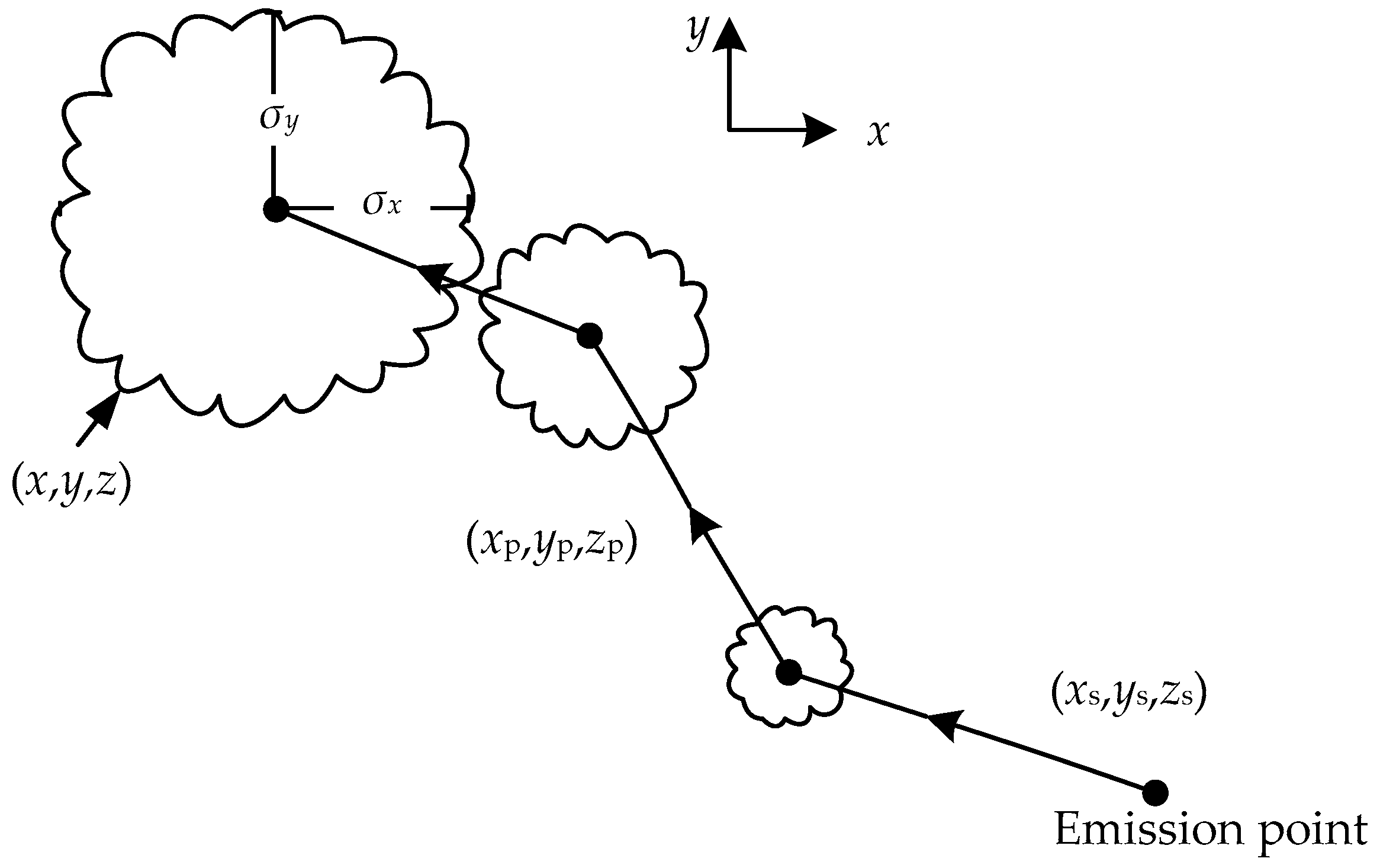
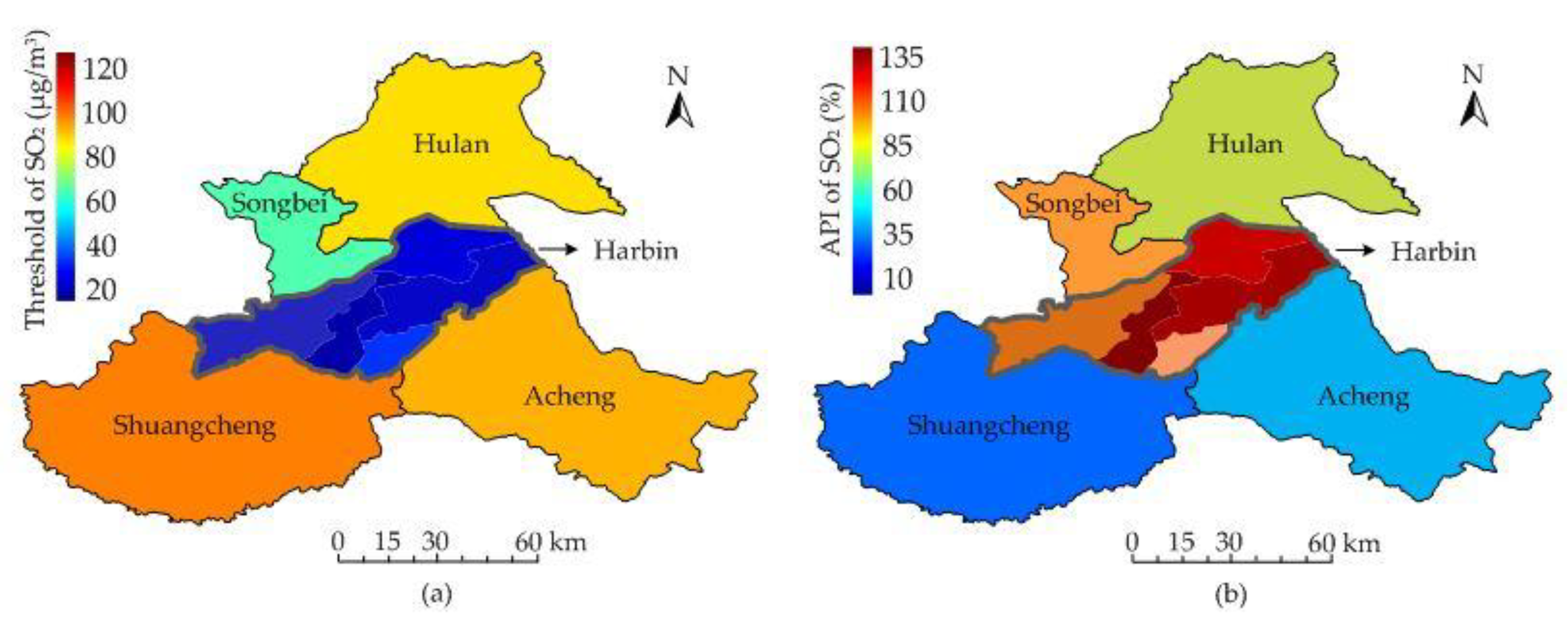
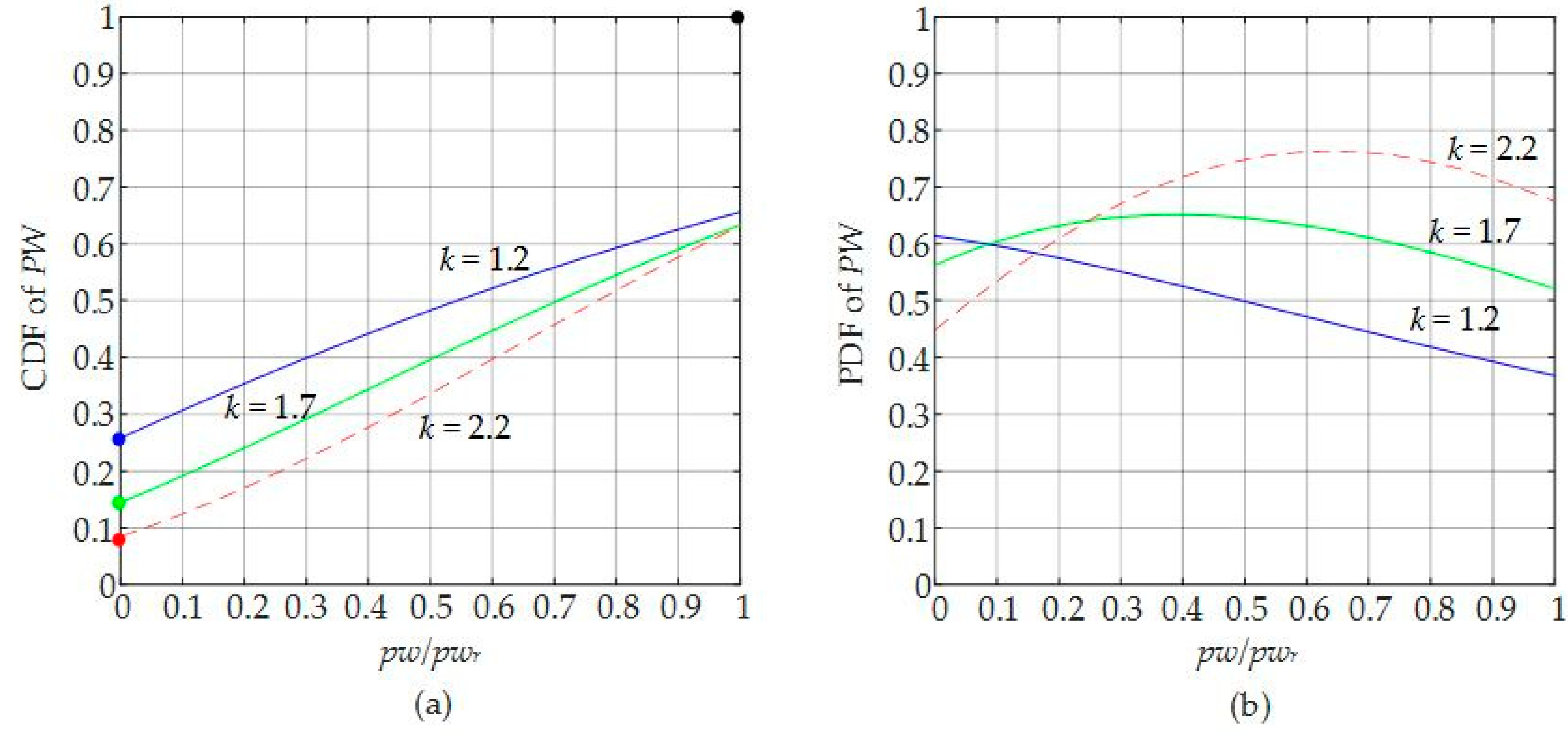

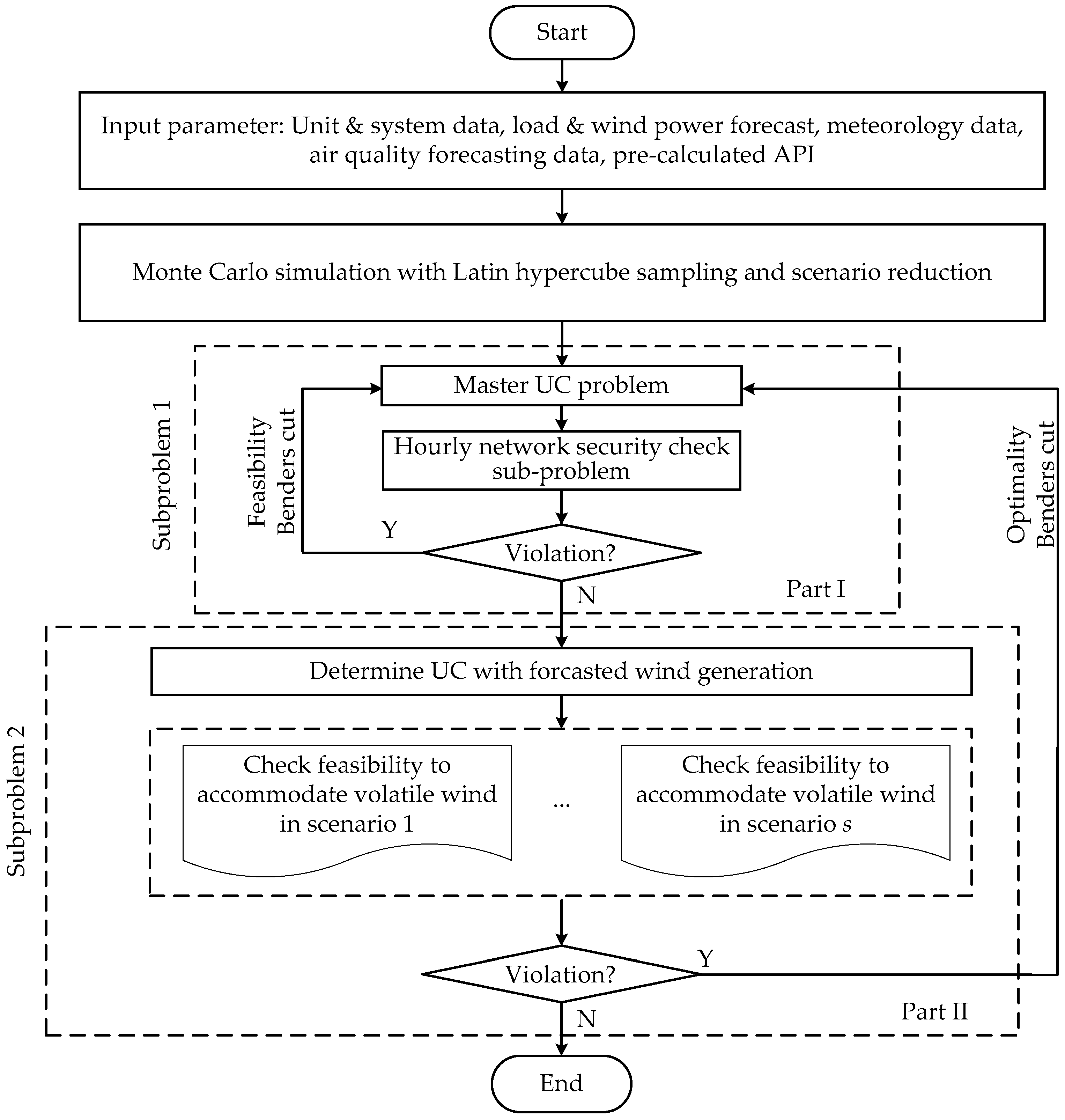
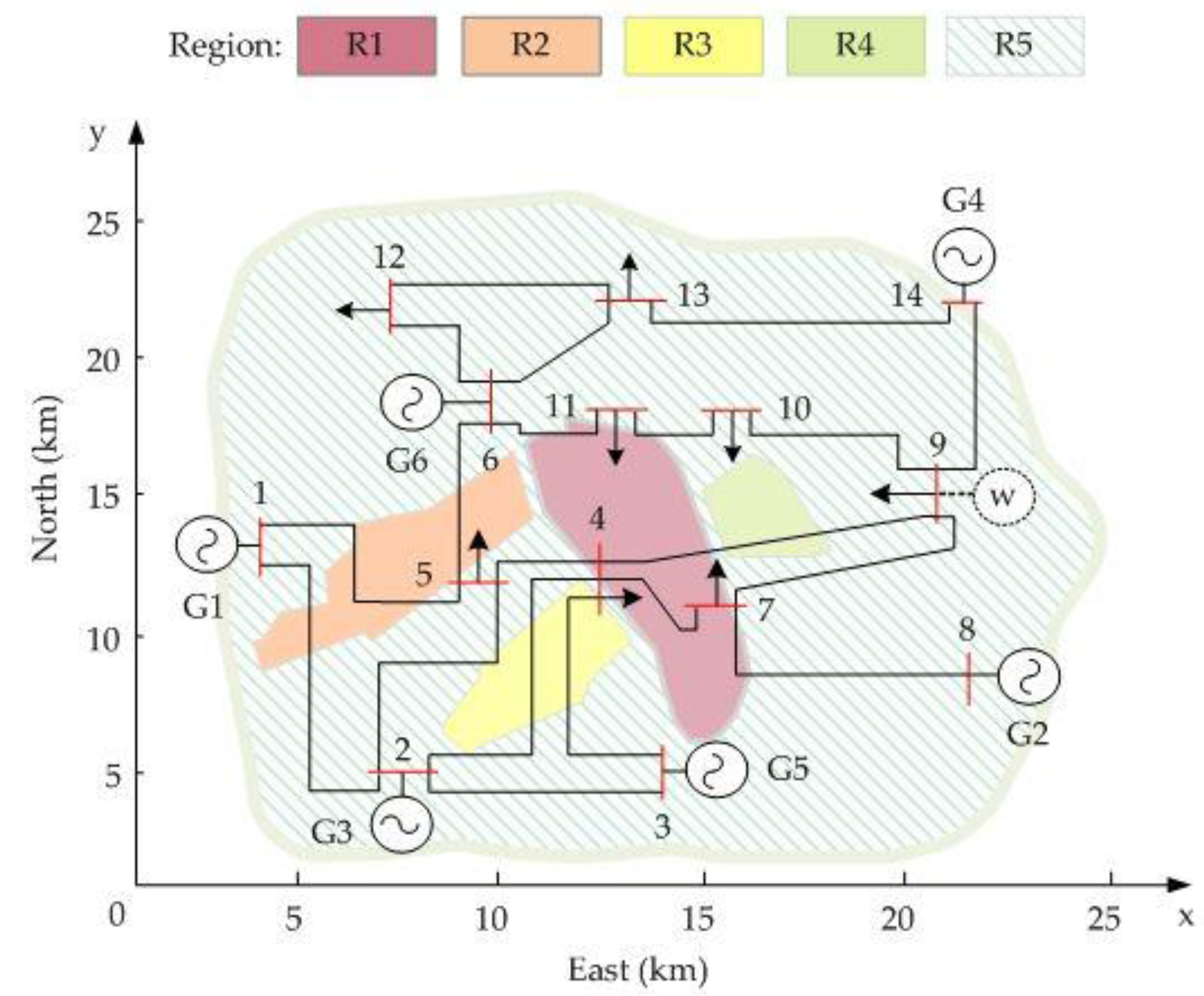
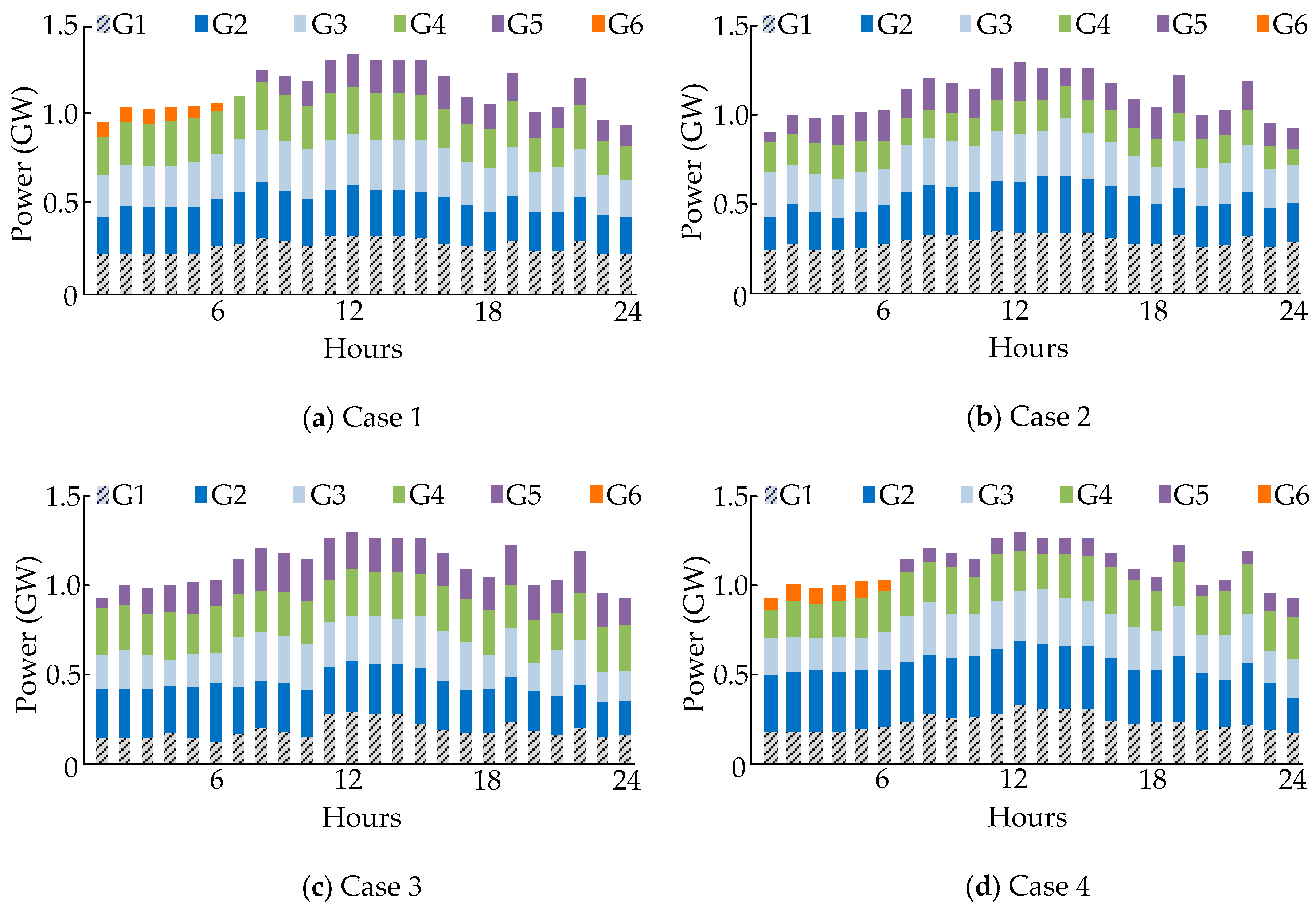
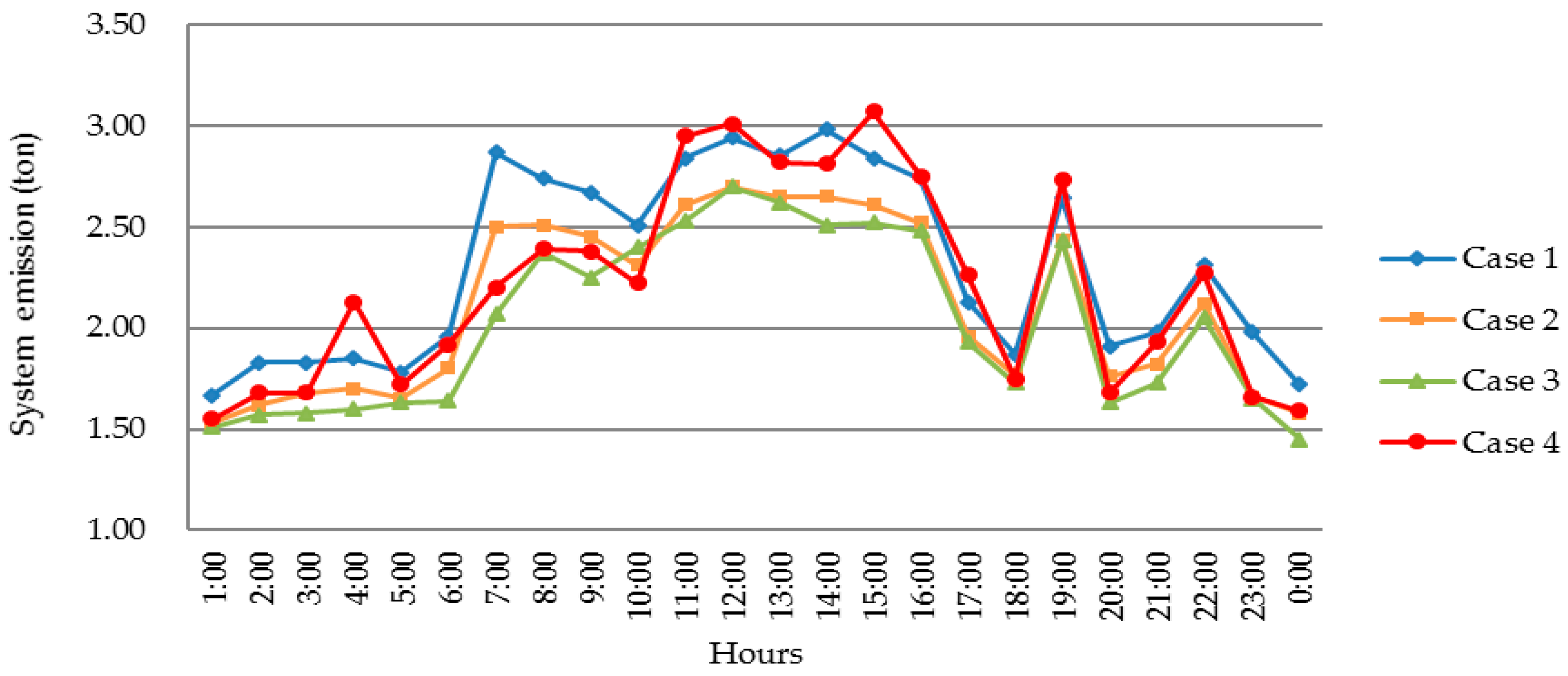
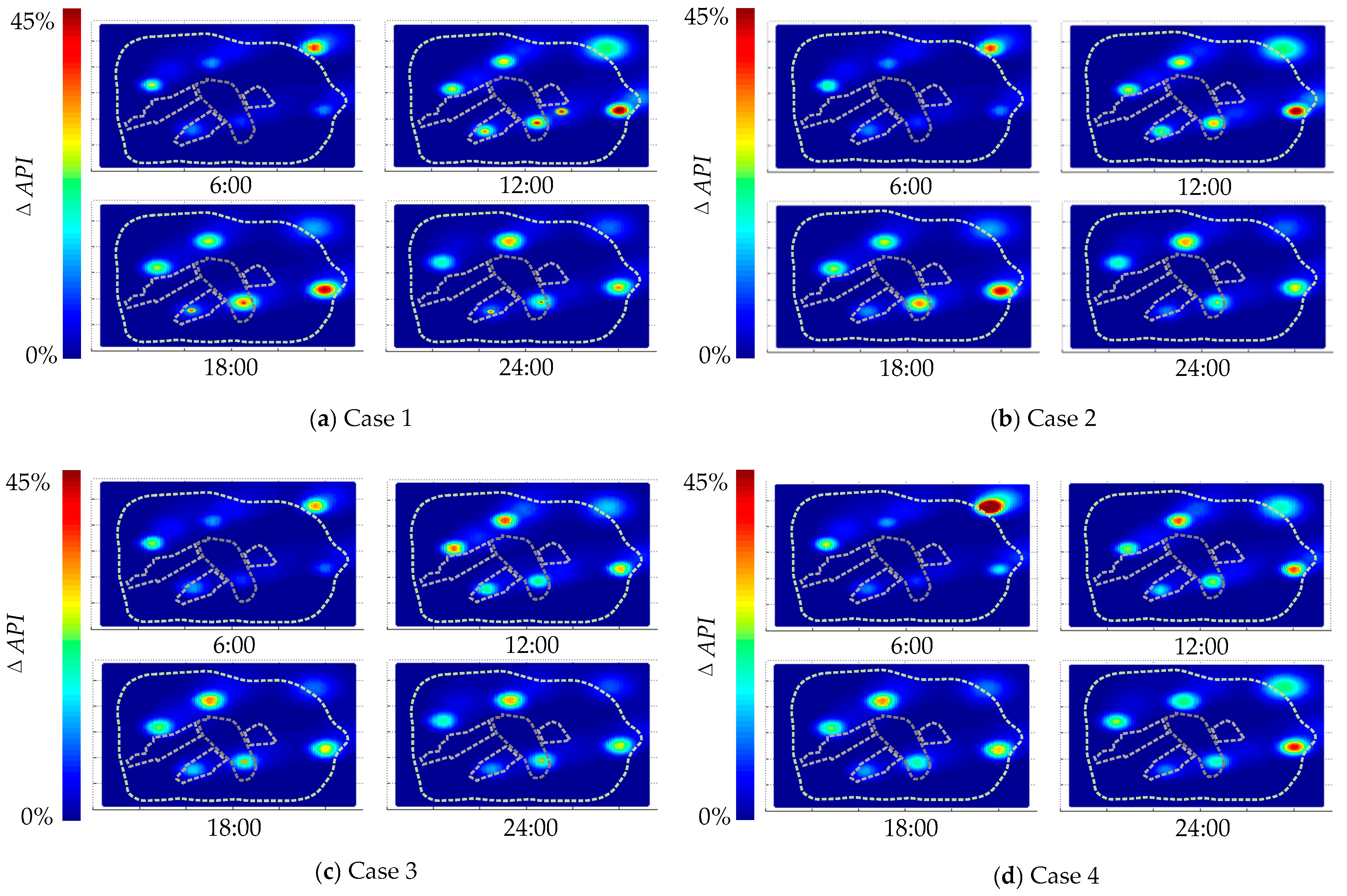

| Case | Cost (103$) | Fuel (ton) | Emission (ton) | Cav (μg/m3) | Cpk (μg/m3) | ||||||||
|---|---|---|---|---|---|---|---|---|---|---|---|---|---|
| R1 | R2 | R3 | R4 | R5 | R1 | R2 | R3 | R4 | R5 | ||||
| 1 | 595.93 | 10138.0 | 55.4 | 60.2 | 57.6 | 52.9 | 41.3 | 38.1 | 70.7 | 68.2 | 65.1 | 53.2 | 49.0 |
| 2 | 512.73 | 8683.8 | 50.5 | 59.9 | 55.7 | 50.4 | 40.1 | 36.5 | 68.8 | 63.9 | 57.3 | 48.4 | 45.4 |
| 3 | 523.46 | 8957.2 | 48.5 | 55.5 | 51.2 | 47.1 | 38.2 | 31.2 | 66.4 | 60.1 | 53.3 | 45.1 | 43.1 |
| 4 | 527.62 | 9174.2 | 53.2 | 50.2 | 47.0 | 43.3 | 35.3 | 39.8 | 57.9 | 54.3 | 48.4 | 41.4 | 49.6 |
| Unit | Traditional SCUC (Case 3) | Eco-SCUC (Case 4) | ||||||||||
|---|---|---|---|---|---|---|---|---|---|---|---|---|
| Generation (MW) | ΔAPIi,av 1 | Generation (MW) | ΔAPIi,av 1 | |||||||||
| R1 | R2 | R3 | R4 | R5 | R1 | R2 | R3 | R4 | R5 | |||
| G1 | 4763.7 | 0.0% | 0.3% | 0.0% | 0.0% | 0.7% | 5572.5 | 0.0% | 0.5% | 0.0% | 0.0% | 3.4% |
| G2 | 5334.9 | 0.5% | 0.0% | 0.0% | 5.6% | 0.9% | 6015.8 | 0.8% | 0.0% | 0.0% | 6.8% | 5.1% |
| G3 | 5518.5 | 1.1% | 15.6% | 12.3% | 0.0% | 1.1% | 5044.2 | 0.8% | 9.4% | 9.1% | 0.0% | 0.9% |
| G4 | 4239.1 | 0.6% | 0.2% | 0.0% | 0.4% | 0.6% | 4763.9 | 0.9% | 0.3% | 0.0% | 0.6% | 1.2% |
| G5 | 3678.4 | 31.4% | 14.4% | 13.5% | 9.8% | 0.5% | 1622.1 | 15.9% | 7.1% | 7.2% | 1.5% | 0.4% |
| G6 | 0.0 | 0.0% | 0.0% | 0.0% | 0.0% | 0.0% | 516.1 | 0.0% | 0.0% | 0.0% | 0.0% | 7.1% |
| Total | 23534.6 | 33.6% | 30.5% | 25.8% | 15.8% | 3.8% | 23534.6 | 18.4% | 17.3% | 16.3% | 8.9% | 18.1% |
| Case | Ts (Hour) | P × Ts (109 Person·Hour) | ||||
|---|---|---|---|---|---|---|
| R1 | R2 | R3 | R4 | R5 | Sum of R1–R5 | |
| 1 | 1101 | 733 | 411 | 194 | 59 | 4.078 |
| 2 | 1056 | 685 | 398 | 181 | 55 | 3.754 |
| 3 | 1063 | 719 | 379 | 178 | 57 | 3.894 |
| 4 | 561 | 437 | 316 | 153 | 63 | 2.204 |
© 2018 by the authors. Licensee MDPI, Basel, Switzerland. This article is an open access article distributed under the terms and conditions of the Creative Commons Attribution (CC BY) license (http://creativecommons.org/licenses/by/4.0/).
Share and Cite
Guo, D.; Yu, J.; Ban, M. Security-Constrained Unit Commitment Considering Differentiated Regional Air Pollutant Intensity. Sustainability 2018, 10, 1433. https://doi.org/10.3390/su10051433
Guo D, Yu J, Ban M. Security-Constrained Unit Commitment Considering Differentiated Regional Air Pollutant Intensity. Sustainability. 2018; 10(5):1433. https://doi.org/10.3390/su10051433
Chicago/Turabian StyleGuo, Danyang, Jilai Yu, and Mingfei Ban. 2018. "Security-Constrained Unit Commitment Considering Differentiated Regional Air Pollutant Intensity" Sustainability 10, no. 5: 1433. https://doi.org/10.3390/su10051433
APA StyleGuo, D., Yu, J., & Ban, M. (2018). Security-Constrained Unit Commitment Considering Differentiated Regional Air Pollutant Intensity. Sustainability, 10(5), 1433. https://doi.org/10.3390/su10051433





